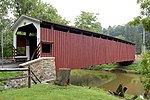Robert Fulton Birthplace
Biographical museums in PennsylvaniaBirthplaces of individual peopleHistoric house museums in PennsylvaniaHouses completed in 1750Houses in Lancaster County, Pennsylvania ... and 5 more
Houses on the National Register of Historic Places in PennsylvaniaMuseums in Lancaster County, PennsylvaniaNational Historic Landmarks in PennsylvaniaNational Register of Historic Places in Lancaster County, PennsylvaniaUse mdy dates from August 2023

The Robert Fulton Birthplace is a historic house museum at 1932 Robert Fulton Highway (U.S. Route 222) south of Quarryville, Pennsylvania. Built in the mid-18th century and reconstructed after a fire demolished it in 1822, it was the birthplace of inventor Robert Fulton (1765–1815). Fulton is best known for the development of commercially viable steamboats as a means of transportation. The house was declared a National Historic Landmark in 1964. The property is owned by the Southern Lancaster Historical Society which gives weekend tours of the house from Memorial Day through Labor Day.
Excerpt from the Wikipedia article Robert Fulton Birthplace (License: CC BY-SA 3.0, Authors, Images).Robert Fulton Birthplace
Fulton Inn Road, Fulton Township
Geographical coordinates (GPS) Address External links Nearby Places Show on map
Geographical coordinates (GPS)
| Latitude | Longitude |
|---|---|
| N 39.804722222222 ° | E -76.160277777778 ° |
Address
Robert Fulton Birthplace
Fulton Inn Road
17563 Fulton Township
Pennsylvania, United States
Open on Google Maps







